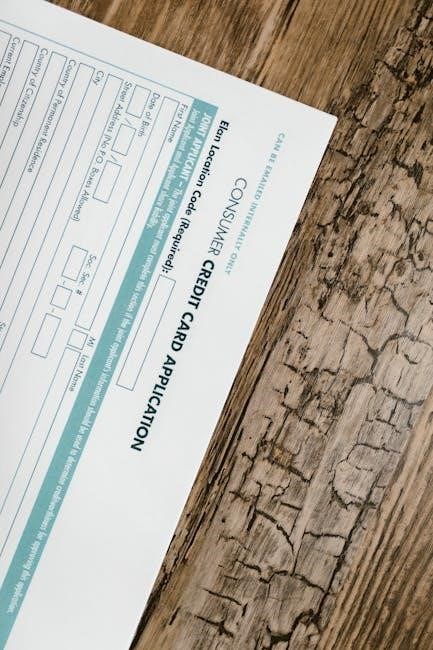Form 410 is a standardized rental application used in Ontario to assess potential tenants. It collects personal, financial, and rental history details, aiding landlords in evaluating applicants.
1.1 Purpose of Form 410
Form 410 is designed to streamline the rental application process in Ontario, providing a standardized method for landlords to evaluate potential tenants. Its primary purpose is to collect essential information about applicants, including personal details, employment history, financial stability, and rental background. This helps landlords assess the suitability and reliability of candidates; The form also ensures transparency and fairness in the tenant selection process. By standardizing the application process, Form 410 protects both landlords and tenants by ensuring all necessary information is disclosed upfront. It is a crucial document for initiating a rental agreement in Ontario.
1.2 Importance of the Rental Application Process
The rental application process is vital for ensuring a smooth landlord-tenant relationship. It allows landlords to evaluate applicants’ credibility, financial stability, and rental history, reducing risks of non-payment or property damage. Tenants benefit from a fair and transparent process, knowing their information is used consistently. Form 410 plays a key role by standardizing this process, ensuring all necessary details are collected. A thorough application process fosters trust and accountability, setting the foundation for a mutually beneficial tenancy. It also helps prevent disputes by clearly outlining expectations and requirements upfront.
Structure of Form 410
Form 410 is organized into sections, including personal information, employment details, rental history, and references, ensuring a comprehensive evaluation of potential tenants.
2;1 Personal Information Section
The personal information section of Form 410 requires applicants to provide their full name, date of birth, contact details, and social insurance number. This section also includes fields for listing current and previous addresses, ensuring landlords can verify residency history. Additionally, applicants may be asked about their marital status, number of dependents, and any vehicles they own. This section is crucial for landlords to assess the applicant’s identity and stability. The information collected here serves as the foundation for further evaluations, such as employment and rental history checks, which are essential for determining suitability as a tenant.
2.2 Employment and Financial Details
The employment and financial details section of Form 410 requires applicants to provide their employment history, current job title, and employer contact information. It also asks for monthly income, sources of income, and financial statements such as bank account details. Applicants may need to include proof of employment, like a letter from their employer or recent pay stubs. This section helps landlords assess the applicant’s financial stability and ability to pay rent consistently. Additional fields may request information about investments, retirement funds, or other income sources to ensure a comprehensive understanding of the applicant’s financial situation.
2.3 Rental History and References
The rental history and references section of Form 410 requires applicants to provide details about their previous landlords or property managers, including names, addresses, and contact information. This helps landlords verify the applicant’s rental behavior and reliability. Applicants may also be asked to explain any gaps in their rental history or provide reasons for moving. Additionally, personal or professional references may be requested to further assess the applicant’s credibility. This section is crucial for landlords to evaluate the applicant’s suitability as a tenant and ensure a hassle-free tenancy experience. Accurate and complete information is essential for a positive evaluation.
2.4 Additional Requirements and Disclosures
Form 410 includes a section for additional requirements and disclosures, where applicants may need to provide information about pets, smoking habits, or other specific conditions. This section ensures landlords are aware of potential factors that could affect the tenancy. Applicants may also be required to sign acknowledgments or disclosures, such as understanding that the application is not a lease agreement. This part of the form may also clarify policies on deposits, application fees, or the return of deposits if the application is denied. It ensures transparency and outlines the terms under which the application is being considered.

How to Fill Out Form 410
Complete Form 410 by providing accurate personal details, employment information, rental history, and references. Ensure all sections are filled thoroughly to avoid delays in processing your application.
3.1 Step-by-Step Guide to Completing the Form
Start by filling in your personal details, including full name, contact information, and current address.
Provide employment information, such as your job title, employer’s name, and duration of employment.
Disclose your financial status, including monthly income and bank account details.
List your rental history with previous landlords’ names, addresses, and tenancy dates.
Supply professional and personal references with their contact details.
Review the form for accuracy and completeness.
Sign and date the application.
Ensure all information is truthful and supported by necessary documentation to avoid delays in processing.
3.2 Common Mistakes to Avoid
When completing Form 410, avoid incomplete sections, as this may delay processing. Ensure all personal, employment, and financial details are accurate and truthful. Double-check for typos or missing information. Do not omit rental history or references, as landlords rely on this data to assess credibility. Avoid submitting the form without required documentation, such as proof of income or identification. Ensure signatures are included where necessary, as unsigned forms may be deemed invalid. Lastly, review the form thoroughly before submission to prevent errors or omissions that could harm your application’s chances. Attention to detail is crucial for a smooth process.
3.3 Tips for a Successful Application
To ensure a successful Form 410 submission, provide complete and truthful information. Include all required supporting documents, such as proof of income, employment verification, and rental history. Double-check for accuracy and completeness before submitting. Submit the application promptly to avoid delays, and consider using digital tools like PDFLiner for efficient completion. Ensure references are reliable and reachable, as landlords may contact them. Be transparent about past rental issues, if any, and address them proactively. Following these steps enhances your credibility and improves your chances of approval. Timeliness and thoroughness are key to a positive outcome.

Legal Implications of Form 410
Form 410 is non-binding until a lease is signed. It must comply with Ontario’s Residential Tenancies Act, ensuring no illegal questions or discrimination. If rejected, deposits must be refunded.
4.1 Understanding the Rental Application Process in Ontario
The rental application process in Ontario involves submitting Form 410, which provides landlords with necessary details to assess tenant suitability; Tenants must include personal information, employment verification, rental history, and references. Landlords review these documents to evaluate creditworthiness and reliability. The process must comply with the Residential Tenancies Act, ensuring no discriminatory or illegal questions are asked. Form 410 is not legally binding until a lease is signed. If an application is rejected, any deposits must be refunded. This process balances tenant rights with landlord needs, ensuring a fair and transparent evaluation of potential tenants in Ontario.
4.2 Landlord and Tenant Board (LTB) Regulations
The Landlord and Tenant Board (LTB) regulates rental disputes and enforces Ontario’s Residential Tenancies Act. Landlords must use Form 410 to fairly assess tenants without bias. The LTB prohibits illegal questions and ensures tenant rights are protected. Landlords must return deposits if applications are rejected. Tenants can dispute unfair decisions through the LTB, which also handles rent increase requests and eviction matters. Compliance with LTB regulations is crucial for landlords to avoid legal issues, ensuring a balanced rental process that respects both parties’ rights and responsibilities in Ontario.
4.3 Legal Rights and Responsibilities of Tenants
Tenants in Ontario have specific rights and responsibilities under the Residential Tenancies Act. They are entitled to a safe, habitable property and protection from illegal practices, such as discrimination. Tenants must pay rent on time, maintain the rental unit, and comply with the lease agreement. They also have the right to privacy and notice before landlord entry. If disputes arise, tenants can seek resolution through the Landlord and Tenant Board (LTB). Understanding these rights and responsibilities ensures a fair and respectful rental relationship, balancing tenant protections with obligations to landlords and property maintenance.

Required Supporting Documents
Form 410 requires tenants to provide identification, proof of residency, employment verification, financial statements, and reference letters to support their rental application.
5.1 Identification and Proof of Residency
Applicants must provide valid government-issued ID (e.g., driver’s license, passport) and proof of residency, such as utility bills or a lease agreement, to confirm their identity and Ontario residency. These documents help landlords verify credibility and ensure compliance with rental regulations. Additional proof, like bank statements or tax documents, may be requested to confirm financial stability. Ensuring all documents are up-to-date and legible is crucial for a smooth application process. This step is essential for landlords to assess the applicant’s reliability and adherence to tenancy requirements in Ontario.
5.2 Employment Verification and Financial Statements
Applicants must submit employment verification, such as recent pay stubs or a letter from their employer, and financial statements to demonstrate their ability to pay rent. Bank statements, tax returns, or proof of income from other sources (e.g., pensions or investments) may also be required. These documents help landlords assess the applicant’s financial stability and capacity to meet rental obligations consistently. Providing accurate and detailed financial information ensures a thorough evaluation of the applicant’s suitability as a tenant. This step is crucial for landlords to make informed decisions and mitigate potential risks associated with renting their property.
5.3 Rental History and Reference Letters
Applicants are required to provide a detailed rental history, including names and contact information of previous landlords or property managers. Reference letters from prior landlords or property management companies are often requested to verify the applicant’s reliability and past behavior as a tenant. This section helps landlords assess the applicant’s credibility and likelihood of fulfilling their rental obligations. Providing accurate and complete rental history ensures a comprehensive evaluation of the applicant’s suitability. Failure to disclose relevant information or providing false details may result in the application being rejected, emphasizing the importance of transparency in this process.

Submitting the Rental Application
Submit Form 410 to the landlord either in person, via email, or through an online platform like LandlordEzy.ca. Ensure all required documents are included for timely processing.
6.1 How to Submit the Application to the Landlord
To submit Form 410, applicants can deliver it in person, email it, or use online platforms like LandlordEzy.ca. Ensure all required documents, such as identification, employment verification, and rental history, are included. Digital submissions via platforms like LandlordEzy.ca streamline the process, offering organized and secure delivery. Applicants should confirm the preferred submission method with the landlord beforehand. Once submitted, the landlord will review the application and may contact references or request additional information. Timely submission with all necessary documentation increases the likelihood of a smooth and efficient rental application process.
6.2 What to Expect After Submission
After submitting Form 410, landlords typically review the application, verifying details like employment, financial stability, and rental history. They may contact references or conduct credit checks. Applicants should expect a response within a few days, though processing times vary. If approved, landlords may request a security deposit and a signed lease. If denied, they must return any deposits. Digital tools like LandlordEzy.ca can provide status updates. Applicants should stay proactive, following up politely if needed. This process ensures both parties assess suitability and proceed confidently, fostering a transparent rental relationship from the start.
6.3 Processing Time and Notification
The processing time for Form 410 varies, typically ranging from a few days to a week, depending on the landlord’s workload. Applicants are usually notified via email or phone once a decision is made. If approved, the landlord will outline next steps, such as signing the lease or paying a security deposit. If denied, the landlord must return any deposits and may provide a reason for rejection. Digital platforms like LandlordEzy.ca offer tools to track the application status. Applicants should follow up politely if they haven’t received a response within 7-10 business days to ensure their application is being processed.

Understanding the Ontario Standard Lease
The Ontario Standard Lease is a legally binding agreement outlining rental terms, rights, and responsibilities for both tenants and landlords, distinct from Form 410’s application purpose.
7.1 Key Components of the Standard Lease Agreement
The Ontario Standard Lease Agreement is a legally binding document that outlines the terms and conditions of a tenancy. It includes details such as rent amount, payment terms, and responsibilities for utilities. The lease specifies the duration of the agreement, rules for subletting, and procedures for terminating the tenancy. It also clarifies the rights and obligations of both landlords and tenants, ensuring transparency and reducing potential disputes. Additionally, the lease addresses property maintenance, repairs, and the use of shared spaces. By law, this lease must be used for all tenancies in Ontario, providing a clear framework for both parties to follow.
7.2 Differences Between Form 410 and the Lease Agreement
Form 410 is a rental application used to assess potential tenants, while the Ontario Standard Lease Agreement is a legally binding contract outlining tenancy terms. Form 410 collects personal, financial, and rental history details to evaluate applicants, whereas the lease agreement specifies rent, duration, and responsibilities. The lease is required by law for all tenancies in Ontario, ensuring transparency and compliance with provincial regulations. Unlike Form 410, the lease agreement is provided after the application is approved and a deposit is made. It serves as the official record of the tenancy, while Form 410 is a preliminary step in the rental process.
7.3 Importance of Reviewing the Lease Before Signing
Reviewing the lease before signing is crucial to ensure understanding of all terms and conditions. It outlines the rent, duration, and responsibilities of both tenant and landlord, preventing future disputes. Tenants should check for any additional fees, rules, or clauses that may not have been discussed. Ensuring the lease aligns with the Ontario Standard Lease requirements is also important for legal compliance. Taking the time to thoroughly review the document protects both parties and ensures a clear agreement from the start of the tenancy. Seeking legal advice if unsure about any terms is highly recommended to avoid potential issues.
Role of the Landlord and Tenant Board (LTB)
The Landlord and Tenant Board (LTB) is Ontario’s regulatory body for resolving rental disputes, mediating conflicts, and providing essential forms and guidance to ensure compliance with rental laws.
8.1 Overview of the LTB and Its Functions
The Landlord and Tenant Board (LTB) is Ontario’s regulatory body overseeing rental disputes, mediating conflicts, and ensuring compliance with rental laws. It provides essential forms like Form 410 and the Ontario Standard Lease. The LTB resolves issues such as rent increases, evictions, and repairs, offering a fair platform for both landlords and tenants. It also educates on tenant and landlord rights, promoting a balanced rental market. By handling disputes and providing resources, the LTB plays a crucial role in maintaining Ontario’s rental housing system.
8.2 How the LTB Handles Rental Disputes
The Landlord and Tenant Board (LTB) resolves rental disputes through formal applications, evidence submission, and witness statements. The LTB prioritizes cases like above-guideline rent increases and eviction requests, ensuring fair hearings. Mediation is often used to settle disputes without full hearings. Tenants and landlords can submit forms online, streamlining the process. The LTB also provides resources to help parties understand their rights and obligations, fostering resolution. By handling disputes efficiently, the LTB maintains balance in Ontario’s rental market, ensuring legal compliance and protecting both parties’ interests.
8.3 Resources and Forms Provided by the LTB
The Landlord and Tenant Board (LTB) offers various resources to assist landlords and tenants, including forms, guidelines, and dispute resolution tools. Key forms include rental applications like Form 410, eviction notices, and rent increase requests. The LTB also provides instructional guides and checklists to help navigate the legal process. Their website features a portal for submitting applications and tracking cases. Additionally, the LTB offers educational materials on tenant rights, rental agreements, and property maintenance. These resources ensure both parties understand their obligations, promoting fair and informed rental practices across Ontario.
Property Management Services in Ontario
Property management services in Ontario handle rental properties, including leasing, maintenance, and tenant relations. They ensure legal compliance, offering expert support for landlords to maximize investment returns effectively.
9.1 Role of Property Management Companies
Property management companies in Ontario specialize in overseeing rental properties, handling tasks like tenant screening, lease agreements, and maintenance. They ensure compliance with rental laws, mitigate risks, and optimize returns for landlords. These firms often employ licensed realtors and paralegals, offering expertise in legal matters and tenant relations. Their services include marketing properties, conducting rent negotiations, and managing day-to-day operations. By streamlining processes, they help landlords maintain profitability while ensuring tenant satisfaction and legal adherence, making them invaluable for both small and large-scale rental investments across Ontario.
9.2 Benefits of Using Professional Property Managers
Engaging professional property managers offers numerous advantages for Ontario landlords. They handle tenant screening, ensuring thorough background checks and rental history verification, which minimizes the risk of problematic tenants. Managers also oversee lease preparation, rent collection, and maintenance, freeing landlords from day-to-day responsibilities. Their expertise in Ontario’s rental laws and regulations helps avoid legal disputes and ensures compliance with the Residential Tenancies Act. Additionally, they provide market insights to set competitive rents and manage tenant relationships effectively. This professionalism fosters tenant retention, reduces vacancy periods, and maximizes property investment returns, making it a wise choice for landlords seeking reliable and stress-free property management.
9.3 Services Offered by Property Management Firms
Property management firms in Ontario offer comprehensive services tailored to landlords and investors. These include tenant screening using tools like Form 410, lease preparation, and rent collection. They also handle maintenance coordination, ensuring properties are well-maintained and repaired promptly. Additionally, firms provide financial reporting, including rent receipts and annual statements, to help landlords track income and expenses; Their expertise in Ontario’s rental laws ensures compliance with regulations, reducing legal risks. Many firms also offer support with LTB matters, eviction processes, and dispute resolution. These services streamline property ownership, allowing landlords to focus on their investments while professionals manage daily operations and tenant relations.

Best Practices for Tenants and Landlords
Effective communication, transparency, and mutual respect are key. Tenants should provide accurate information, while landlords should ensure fair screening and comply with Ontario rental laws using tools like Form 410.
10.1 Tips for Tenants When Applying for Rental Properties
When applying for rental properties in Ontario, tenants should carefully review and complete Form 410 accurately. Ensure all personal, employment, and rental history details are truthful and verifiable. Organize required documents, such as identification, proof of income, and references, beforehand to avoid delays. Tenants should also understand the difference between Form 410 and the lease agreement, as the form is not legally binding until the lease is signed. Asking questions about the property and lease terms before submitting the application can prevent misunderstandings. Transparency and preparedness are key to a smooth rental application process.
10.2 Best Practices for Landlords When Screening Applicants
Landlords should use Form 410 to consistently evaluate all applicants, ensuring fairness and compliance with Ontario rental laws. Verify employment, financial stability, and rental history by contacting references and reviewing supporting documents. Avoid discrimination by focusing solely on financial and tenancy-related criteria. Maintain detailed records of all applications and screening processes for transparency and legal protection. Consider using professional property management services for impartial applicant evaluation. Ensure compliance with the Residential Tenancies Act and Landlord and Tenant Board (LTB) regulations throughout the screening process. This approach helps landlords select qualified tenants while maintaining a positive and lawful rental application experience.
10.3 Maintaining a Positive Landlord-Tenant Relationship
Maintaining a positive landlord-tenant relationship begins with clear communication and mutual respect. Ensure all terms and expectations are outlined in the Ontario Standard Lease Agreement, fostering trust and understanding. Regularly address maintenance issues promptly to prevent disputes. Provide tenants with necessary documentation, such as rental receipts, and keep detailed records of all interactions. Encourage open dialogue to resolve issues amicably before they escalate. Consider using property management services to handle day-to-day tasks and ensure compliance with legal standards. By prioritizing professionalism and fairness, landlords can create a harmonious living environment and long-term tenancy.

Key Takeaways
Form 410 is essential for Ontario rental applications, ensuring credibility and streamlining the process. Compliance with rental laws and proper documentation are vital for both landlords and tenants.
11.1 Summary of Form 410 and Its Significance
Form 410, developed by the Ontario Real Estate Association (OREA), is a standardized rental application used to assess potential tenants. It collects essential information such as personal details, employment history, financial status, rental history, and references. This form helps landlords evaluate applicants’ credibility and suitability for a property; While not legally binding, it streamlines the rental process and ensures transparency. Its significance lies in protecting both landlords and tenants by providing a structured framework for rental applications, fostering fair and informed decisions. Proper use of Form 410 promotes compliance with Ontario rental laws and supports a smooth tenancy process.
11.2 Final Tips for a Smooth Rental Application Process
To ensure a seamless rental application process, applicants should thoroughly complete Form 410, providing accurate and detailed information. Gather all required documents, such as proof of employment, financial statements, and rental references, beforehand. Double-check the form for completeness and accuracy to avoid delays. Understand that the form is not legally binding until a lease is signed. Be prepared for follow-ups or additional screenings, such as credit checks or reference verification. Consider using online tools or professional services to streamline the process. By being organized and proactive, applicants can enhance their chances of a successful and stress-free rental application experience.
11.3 Importance of Compliance with Ontario Rental Laws
Compliance with Ontario rental laws is crucial for both landlords and tenants to avoid legal disputes. Form 410 ensures that the rental application process adheres to the Residential Tenancies Act, protecting both parties’ rights. Landlords must use the standardized lease agreement and follow proper screening procedures. Tenants should be aware of their rights, such as privacy and security of personal information. Non-compliance can result in penalties or disputes resolved through the Landlord and Tenant Board. By adhering to legal standards, both parties foster a fair and transparent rental process, ensuring a positive experience for all involved in Ontario’s rental market.
